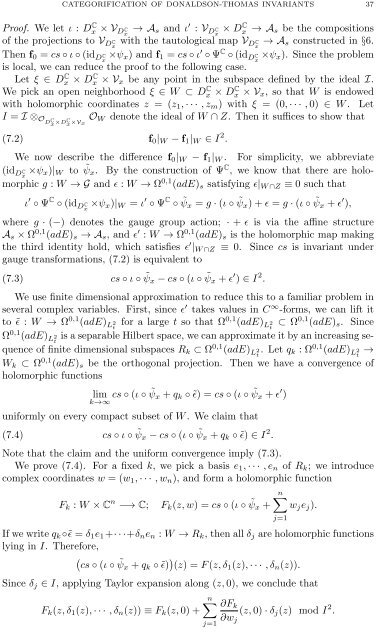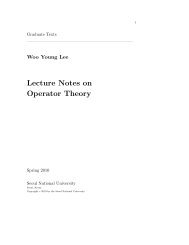Categorification of Donaldson-Thomas invariants via perverse ...
Categorification of Donaldson-Thomas invariants via perverse ...
Categorification of Donaldson-Thomas invariants via perverse ...
You also want an ePaper? Increase the reach of your titles
YUMPU automatically turns print PDFs into web optimized ePapers that Google loves.
CATEGORIFICATION OF DONALDSON-THOMAS INVARIANTS 37Pro<strong>of</strong>. We let ι : Dx C × V D C x→ A s and ι ′ : V D C x× Dx C → A s be the compositions<strong>of</strong> the projections to V D C xwith the tautological map V D C x→ A s constructed in §6.Then f 0 = cs ◦ ι ◦ (id D C x×ψ x ) and f 1 = cs ◦ ι ′ ◦ Ψ C ◦ (id D C x×ψ x ). Since the problemis local, we can reduce the pro<strong>of</strong> to the following case.Let ξ ∈ Dx C × Dx C × V x be any point in the subspace defined by the ideal I.We pick an open neighborhood ξ ∈ W ⊂ Dx C × Dx C × V x , so that W is endowedwith holomorphic coordinates z = (z 1 , · · · , z m ) with ξ = (0, · · · , 0) ∈ W . LetI = I ⊗ OD OC x ×Dx C W denote the ideal <strong>of</strong> W ∩ Z. Then it suffices to show that×Vx(7.2) f 0 | W − f 1 | W ∈ I 2 .We now describe the difference f 0 | W − f 1 | W . For simplicity, we abbre<strong>via</strong>te(id D C x×ψ x )| W to ˜ψ x . By the construction <strong>of</strong> Ψ C , we know that there are holomorphicg : W → G and ɛ : W → Ω 0,1 (adE) s satisfying ɛ| W ∩Z ≡ 0 such thatι ′ ◦ Ψ C ◦ (id D C x×ψ x )| W = ι ′ ◦ Ψ C ◦ ˜ψ x = g · (ι ◦ ˜ψ x ) + ɛ = g · (ι ◦ ˜ψ x + ɛ ′ ),where g · (−) denotes the gauge group action; · + ɛ is <strong>via</strong> the affine structureA s × Ω 0,1 (adE) s → A s , and ɛ ′ : W → Ω 0,1 (adE) s is the holomorphic map makingthe third identity hold, which satisfies ɛ ′ | W ∩Z ≡ 0. Since cs is invariant undergauge transformations, (7.2) is equivalent to(7.3) cs ◦ ι ◦ ˜ψ x − cs ◦ (ι ◦ ˜ψ x + ɛ ′ ) ∈ I 2 .We use finite dimensional approximation to reduce this to a familiar problem inseveral complex variables. First, since ɛ ′ takes values in C ∞ -forms, we can lift itto ˜ɛ : W → Ω 0,1 (adE) L 2tfor a large t so that Ω 0,1 (adE) L 2t⊂ Ω 0,1 (adE) s . SinceΩ 0,1 (adE) L 2tis a separable Hilbert space, we can approximate it by an increasing sequence<strong>of</strong> finite dimensional subspaces R k ⊂ Ω 0,1 (adE) L 2t. Let q k : Ω 0,1 (adE) L 2t→W k ⊂ Ω 0,1 (adE) s be the orthogonal projection. Then we have a convergence <strong>of</strong>holomorphic functionslim cs ◦ (ι ◦ ˜ψ x + q k ◦ ˜ɛ) = cs ◦ (ι ◦ ˜ψ x + ɛ ′ )k→∞uniformly on every compact subset <strong>of</strong> W . We claim that(7.4) cs ◦ ι ◦ ˜ψ x − cs ◦ (ι ◦ ˜ψ x + q k ◦ ˜ɛ) ∈ I 2 .Note that the claim and the uniform convergence imply (7.3).We prove (7.4). For a fixed k, we pick a basis e 1 , · · · , e n <strong>of</strong> R k ; we introducecomplex coordinates w = (w 1 , · · · , w n ), and form a holomorphic functionF k : W × C n −→ C; F k (z, w) = cs ◦ (ι ◦ ˜ψn∑x + w j e j ).If we write q k ◦˜ɛ = δ 1 e 1 +· · ·+δ n e n : W → R k , then all δ j are holomorphic functionslying in I. Therefore,(cs ◦ (ι ◦ ˜ψx + q k ◦ ˜ɛ) ) (z) = F (z, δ 1 (z), · · · , δ n (z)).Since δ j ∈ I, applying Taylor expansion along (z, 0), we conclude thatn∑ ∂F kF k (z, δ 1 (z), · · · , δ n (z)) ≡ F k (z, 0) + (z, 0) · δ j (z) mod I 2 .∂w jj=1j=1













